Pruning and Structuring the Branches
Branch Structure - Artistic Principles of Branch Design
Introduction
Branches are an essential part of the tree, and their structure, along with the trunk, provides the first artistic line. Without branches being of equal form and stature you cannot have a good bonsai. Branches need to follow the artistic principles of design as well as the trunk. You should aim to create length, width, and depth. Do this by alternating the horizontal and vertical direction at the forks of the branches.
Branches should follow the same artistic principles and alternate the point at which they grow into new twigs.
You need proportion, harmony and balance to make a complete bonsai
Proportion
Each segment of growth becomes thinner as we move from the base of the primary branch to the tips of the twigs.
Balance
When a branch is viewed from above it should have a symmetrical balanced shape where possible.
The visual mass of the branch should be balanced.
Overly long or thick secondary branches near the tips should be trimmed.
The amount of ramification will determine the density of foliage. Sometimes less is more. Foliage density should be balanced between each branch and the tree as a whole.
Harmony
Harmony is the balance between consistency and contrast, but consistency is the prime factor; stick to a similar style throughout the tree, branches should also follow a similar style.
Proportion produces the harmony of a complete tree.
The Way Forward
Identify the main branch structure – what does that mean and how do we do that?
The classic bonsai is a traditional broom style, with little or no faults, a tapering trunk and exquisite fine branching (ramification) . Only on a broom style will these characteristics be shown quite so precisely but in almost all other styles we are creating, should follow the same basic principles of branch structure. How we create this, is what you are going to learn.
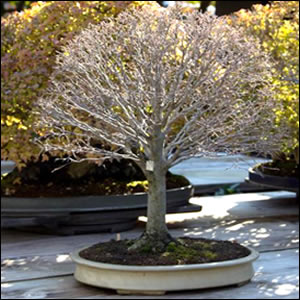
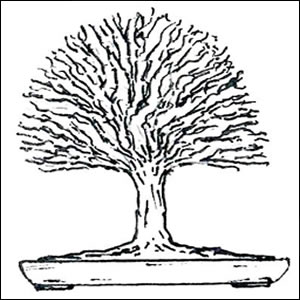
We are aiming to achieve a set of branches that are angled slightly downwards at the base of the tapering trunk, but angling upwards as you reach the apex of the tree. Each branch will be individually creating a similar structure. The girth of individual branches will diminish in proportion to the thickness trunk.
Pruning to Shape
To create the basic shape often involves pruning large branches.
Deciding on which branches should stay and which ones should be removed can be difficult, not only because it is an irreversible action but also because it is part of deciding how the tree will look. Take some time, observe your tree deciding which branches do not fit the desired design and must be removed. You should understand when developing new trunk-lines that:
- The shoots (be they potential branches or leaders) with the most growth will thicken the fastest.
- The shoots with the least growth will thicken slowest.
- To encourage growth in a shoot, do not prune that shoot.
- To encourage maximum growth in a shoot, prune all other shoots on the tree.
- To stop a shoot growing, pinch back that shoot.
- To minimise growth, do not let the new growth extend (pinch the new growth as it opens).
Using these 6 basic principles, you can control which parts of a tree grow and eventually become thicker and which parts remain as they are.
Developing a branch structure and new leader on a bonsai using these principles can sometimes be something of a puzzle. But, if you focus on which parts of the tree (the leader or the branches or a particular branch) require the most growth and which areas of the tree require the least, it is easily solved!
Maintenance pruning is required to maintain a trees' shape. Prune branches/shoots that have outgrown the intended canopy-size/shape using twig shears or a normal cutter. Do not be afraid to prune your bonsai; it is important, especially in the outer and top areas, to prune regularly in order to promote distribution of growth more evenly and develop denser foliage.
Structuring a Tree
At the start of the first year of training your trunk will produce new buds all over the place, seemingly indescriminately. These buds will then begin to open into new shoots as temperatures warm in the spring.
A bare trunk stripped of all shoots and branches in the autumn will produce considerably more buds from the trunk the following spring. Any existing branches that are left after autumn pruning will reduce the number of buds that appear on the trunk itself.
Allow them a season to develop.
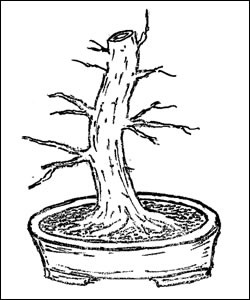
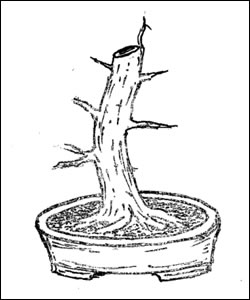
The first step is to decide which new shoots to keep for development into new branches and trunk leaders, and which to remove. The sooner that unwanted shoots are removed, the more ‘energy’ the tree is able to divert into growth and development of the shoots that are wanted.
The exact shoots or buds to keep will depend on the design you have for the tree. If you are uncertain whether a branch will be required in the future, retain it for the time being. It is always easier to remove a bud or shoot than it is to regrow it.
It is important to understand about apical dominance. Every tree species will have a natural growth habit that will produce different rates of growth in shoots depending on their position on the trunk.
- At the uppermost part (a), the tree growth will be strongest. There will be more buds appearing in this area, the shoots that they produce will be more vigorous and will have a greater growth rate.
- Conversely, in the lowest areas of the trunk (c), bud production and shoot growth will be weakest. The areas inbetween (b) will tend to have bud production and shoot growth rates between.
- You will get maximum growth in the new trunk leader and it will thicken rapidly, creating better taper to the top of the trunk.
- Allow it to extend without cutting for at least one season. Area 'a'.
- Area ’b’: Allow each of the middle branches to extend and open 3 or 4 leaves, then pinch out the rest of the new shoot so it will not extend any further, allowing the tree’s resources to be diverted elsewhere.
- Without pruning, the new shoots in the middle part of the tree would grow faster than those shoots in the lowest areas of the trunk producing branches that are thicker than the branches below, so you need to trim back branches in Area 'b'.
- Allow Area 'c' branches to extend further and thus thicken them.
- When the new leader has begun to grow strongly, it will be time to cut off the top of the trunk at an angle to the new apex to create a better taper to the trunk.
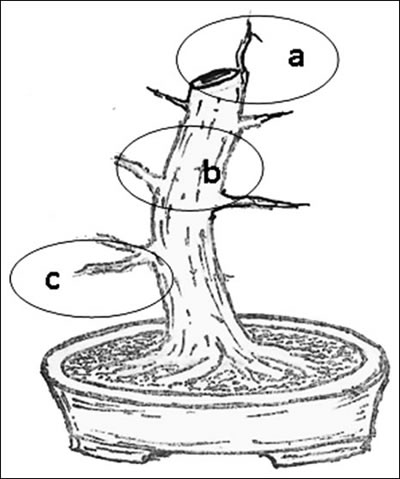
Some tree species are more apically dominant than others. It is only with experience that you will learn which is which. There are smaller number of tree species that are described as being ‘basally dominant’. This simply means that the base of the tree is the strongest.

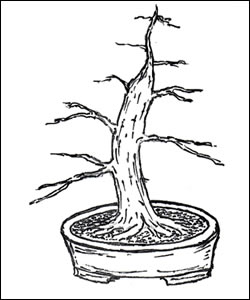
Structuring individual branches and creating Ramification
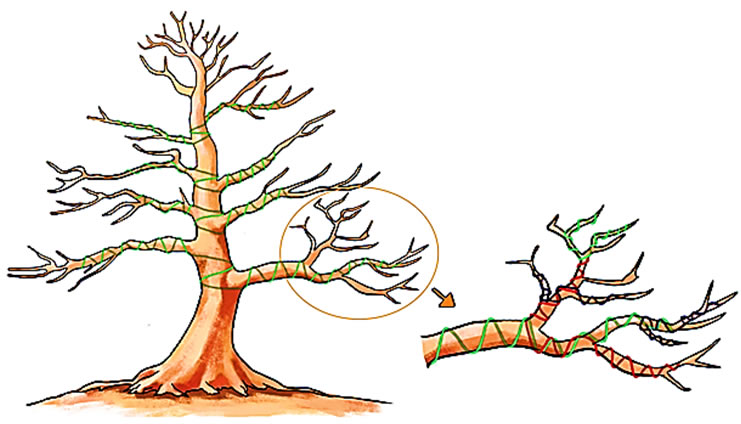
If branches are allowed to grow unchecked for a number of years they will grow to considerable length with few side shoots anywhere other than at the tips – they are growing towards light, near to the trunk; other branches shade out the light.
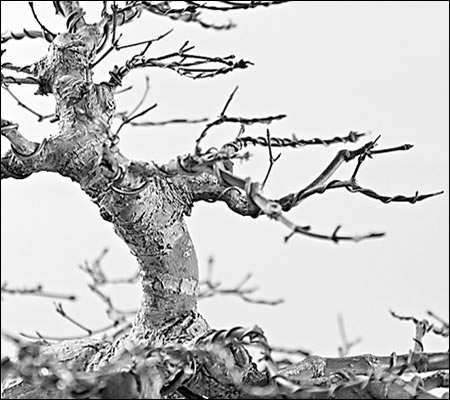
For bonsai purposes you need to control this natural habit – you want a small tree with lots of small branches close to the main trunk. To do this you need carefully controlled cutting and pinching of new shoots to encourage growth where you want it, thus producing the tree you want, not necessarily what tropisms are directing.
As you cut branches you will wire them and place into their desired position. Each of the shoots should not look exactly the same after they have been wired but they must each have a similar movement to each other.
They should look as though they have grown under similar circumstances to each other on the same tree but there must also be an element of randomness to their movement as well.
One of the main purposes of wiring is to create the illusion to the viewer of the bonsai that the tree is a miniature version of one found in the wild and that the bonsai has grown naturally into shape by itself. Long term evidence of wiring and artificial placement should be avoided.
Use twists and bends of similar degrees but in different combinations to achieve a random effect when placing newly wired branches.
Make sure that if the trunk has very heavy twists and turns this is reflected in the movement of the branches as well. Similarly, if the trunk has very slow, gradual bends, its branches should reflect this.
Physiology of Branch Development
Scientists have shown that the main shoot dominates a plant’s growth principally because it grew first rather than due to its position at the top of the plant. This discovery helps explain why pruning encourages plants to thrive.
As branches extend upwards to form the apex of a tree, or outwards from the trunk, as horizontal branches; buds are produced on the sides of the developing branch structures. These buds are initially dormant as the growing tip produces the hormone auxin, which inhibits their development. Once the growing tip has extended sufficiently (depending on the genetic makeup of each species), the concentration of auxin near the terminal bud drops and the remaining buds lower down the length of the branch start to grow sideways.
These new sideways shoots also lay down their own buds which in turn, are kept dormant until the shoots’ own growing tip has extended to a predetermined length (determined by species). When developing bonsai you are going to force the tree to produce its natural reaction; by cutting off its tip you stop the auxins in their track thus making a new shoot develop behind your cut. Allow each required shoot to extend until it is attaining the thickness you require; then, by pinching out the growing tip, further side shoots (branches) will develop.
Auxins are a class of plant hormones (or plant growth regulators). Auxins have a major role in coordination of many growth processes in the plant's life and are essential for plant development. Bonsai must be pruned throughout the growing season to keep them in shape. Some species such as Acers have a number of growth spurts through the year, after each which they require pruning back; other species such as Junipers require continual maintenance pruning. You will use both scissors and your fingers for trimming. This regular pruning will result in denser foliage emerging leading to the creation of foliage pads.

Web design: nysys
